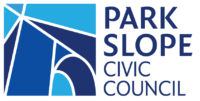 Chilean poet and politician Pablo Neruda once wrote, “Murals are the people’s blackboard.” These often complex, often transitory works of art require a great deal of cooperation among many people in the community, among them artists, neighborhood groups, and mural organizations.
Chilean poet and politician Pablo Neruda once wrote, “Murals are the people’s blackboard.” These often complex, often transitory works of art require a great deal of cooperation among many people in the community, among them artists, neighborhood groups, and mural organizations.
Park Slope has had a complicated relationship with the longstanding community-mural movement. Very few of these wall paintings have ever been undertaken here, and of those, some were actively opposed by residents in the immediate vicinity much like many bike lanes are today.
One of the few community murals remaining in Park Slope today is Water Is the Life of NYC, created in 2008 by the Groundswell Community Mural Project. The mural was funded in part by the Park Slope Civic Council through its yearly Grants Program, whic h is made possible by the generosity of the Council’s membership and the proceeds of the annual House Tour.
The four-story-high Water Is the Life of NYC overlooks an empty lot at the corner of Sackett Street and Fourth Avenue. The mural takes as its subject the city’s water cycle. Water becomes the “connecting device” in the mural, which depicts its course from the pristine Catskills watershed and reservoirs, over the Croton Dam, through the complex tunnel system dug by sandhogs, and to the taps of city residents, who enjoy what has been called the “champagne of municipal water systems.” In the focal point of the mural, a figure is drawing tap water into a reusable bottle.
The mural both celebrates the wonder of the city’s water system and educates us on the importance of resource conservation, maintaining our water supply system, and protecting our upstate watershed from threats such as “hydrofracking.”
The site for this mural is very appropriate, as it is home to an entrance to Water Tunnel No. 3. Situated 600 feet below the surface, the tunnel is the largest capital construction project in state history, and has been under construction since 1970. The tunnel will not be completed until at least 2020, and will allow needed repairs to be made on other tunnels in the city’s water-supply network. The vacant lot, which may become a community park once construction is done, was also a key stop on Moving Forward on Fourth, the Civic Council recent walkabout on Fourth Avenue.
Zane Smith, one of the team of youth and artists who helped produce the mural, said when the finished work was unveiled, “This mural reflects the global issue of water as a precious resource, and as only 7% of the world’s water is drinkable we shouldn’t take our water for granted.” The city’s Department of Environmental Protection, another partner in the mural’s creation, has a slide show of the creative process on its website [INSERT LINK].
Groundswell, which organized the project, is a 14-year-old nonprofit that brings together these collaborative murals to help people use their imaginations in connecting with others and with issues in the community. (Learn more about Groundswell here.)
The organization’s work shows how these murals are highly complex social artifacts. On the Wall: Four Decades of Community Murals in New York City by Janet Braun-Reinitz and Jane Weissman (University of Mississippi Press, 2009), a beautifully illustrated history of New York’s rich murals movement from the 1960s on, helps us understand the complicated processes through which these works come into being. (The quotation from Pablo Neruda comes from the book’s introduction.)
“The true power of these murals lies in their local, community impact, their ability to illuminate issues that resonate with real people, the oppressed, the poor, the overworked, the unrepresented,” Amy Goodman and Denis Moynihan of Democracy Now wrote in their foreword to On the Wall. “The process, the act of community building and collaboration, the beautification that community murals provide, create intangible threads.”
And as the On the Wall authors themselves noted: “A singular art form, these large-scale and site-specific works reflect the social, cultural, and political climate of their times and the neighborhoods in which they are located. Community murals beautify, educate, protest, celebrate, affirm, organize, and motivate residents to action. They are a window into the unwritten history of a neighborhood.”
Water Is the Life is proof of this idea. The mural accurately reflects the rapidly expanding ecological consciousness of the past decade or so. In this sense, Park Slope’s community mural is indeed a “people’s blackboard,” as Neruda contended.
These monumental paintings are also a highly transitory art form. They weather and fade; the walls on which they are painted can be repaired or altered; their host building can be demolished; they can be obscured by new construction. Many works created in the last 40 years have been lost to these forces.
Park Slope today is underserved by community murals, and more of them should be created here. More recovered history of Park Slope’s community murals has been posted on the Save the Slope blog.
— David Alquist, a Civic Council Trustee, also serves on the Historic District Expansion and House Tour committees. Photo by David Herman.
from the November 2010 Civic News

